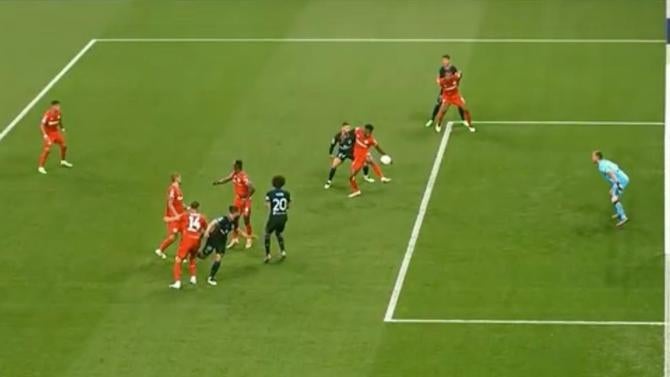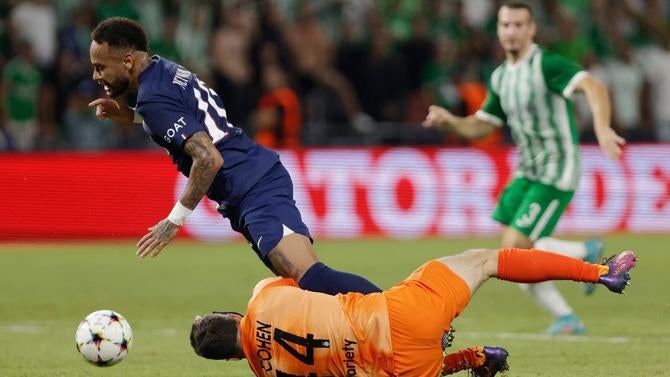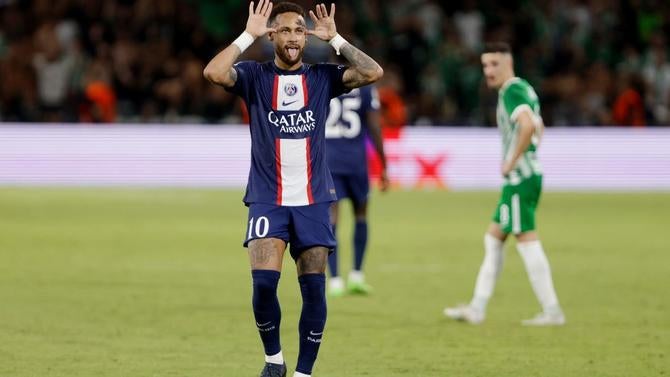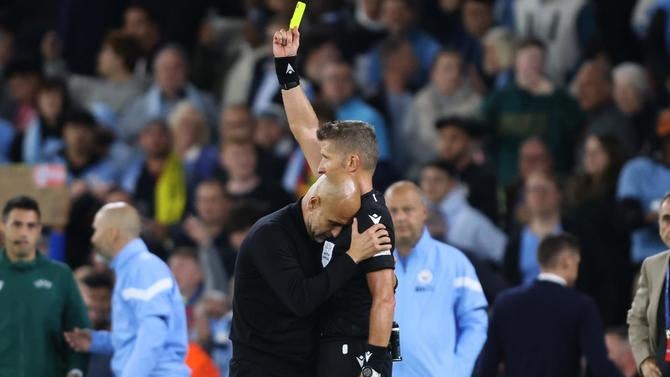Champions League’s biggest calls: Neymar’s taunt, the Napoli vs. Rangers penalty circus, Guardiola’s hug, more
Written by ABC Audio All Rights Reserved on September 16, 2022
This week we look at three controversial decisions by the referee teams, including one that continues to baffle pundits as to what is a handling offense. Let’s take a look at those moments, and as an official referee I’ll walk you through whether those calls were right, and what makes them so complicated. We’ll take a look at the yellow card tackle on Ousmane Dembele, recap the wild happenings in Rangers vs. Napoli under the charge of the 2021 UEFA Champions League final referee and more. Also, we’ll focus on why moments like Neymar taunting the fans are being eradicated from the game . It’s for his own safety, even if he may not appreciate or understand it. And finally, at the end of a long day, we’ll see that even referees can need a hug.
What even is handling anyway?
Last week I broke down the six IFAB principles that guided a 2019-20 major rewrite of the law. So when we take a look at the handling that occurred in the 22nd minute by Leverkusen’s Edmond Tapsoba against Atletico de Madrid, there is only one answer you can get to: it was a missed decision on the field and a missed VAR recommendation.
In fairness to English referee Michael Oliver, this is nearly impossible to get in real-time. Did Oliver know it contacted Tapsoba’s arm/hand? Yes. But could Oliver be able to judge whether Tapsoba’s arm/hand was unnaturally bigger because it was not justifiable for it to be in that position for that that specific situation? No.
The contact occurs on Tapsoba’s left arm/hand which is fully shielded to Oliver as he is in the right position for the cross. Since the arm is behind Tapsoba and in the center of the goal area, it would also be nearly impossible for the assistant referee to give accurate information.
So this is what VAR is created for. Fellow English colleagues, VAR Chirs Kavanagh and assistant VAR Stuart Atwell, are at the helm with the sole task to determine whether Tapsoba’s arm is unnaturally bigger and unjustifiable given the facts in this specific play.
Here are the facts:
-
It is a long cross into the penalty area that Tapsoba is prepared for.
-
There is a flick-on by an Atletico player, but Tapbsoba can see it, and he is still 3-5 yards away.
-
The flick-on is an expected football play in this situation.
-
Tapsoba does attempt to play the ball by raising his left foot.
-
At the point of contact on the hand/arm, Tapsoba’s arm is backwards and not moving towards the ball but is away from his body.
-
If the ball had not hit the hand/arm, the ball would have passed Tapsoba completely (no other fair body part of Tapsoba was behind his hand/arm) to Atletico’s Mario Hermoso who was just behind him.
With those facts outlined, the VAR now has to determine whether Tapsoba’s arm, which is making his body bigger and outside the silhouette, is justifiable for his movement of trying to play the ball. Tapsoba’s arm does ultimately take up space and significantly alters the flight of the ball on the top of the goal area about seven yards from the goal.
Here is where you can make some meaningful debates. Of the six principles the football community accepts, the one that is challenged is whether Tapsoba gains a major advantage by contacting the ball with his arm. In this situation, he literally stops the ball and it drops to the feet of Hermoso who quickly tries to put it back in the net and misses high.
However, the handling offense’s core type of offense is an impact-based offense, meaning whether the offense had an impact on the play in that specific situation. Here, the clear answer is yes. Referees very rarely apply advantage in the penalty area unless it does go in the back of the net. Why? Because the alternative is a penalty kick – which every team would prefer over a goal kick after an advantage.
The Final Decision: Handling, penalty and yellow card.
Tapsoba’s arm is outside his silhouette and takes up fair space and significantly impacts the play. It is not justifiable and should have been recommended for a handling offense, penalty kick and yellow card to Tapsoba. To focus on Hermosa being able to hit the ball quickly after the handling offense is a detractor to what football wants — a penalty kick in this play with 0-0 early in the match — no advantage.
VAR slow speed vs. real-time speed
Bayern’s Alphonso Davies may have gotten away with one against Dembele for his defensive play in the penalty area in the 43rd minute between Bayern and Barcelona. The football community and the referee community is divided on this one but ultimately we need to come to a final decision, even if it is by the slightest margin.
The decision on the field by the referee was no foul and no penalty when Davies swiftly stepped into the space right where Dembele’s next step was to occur. However, you will have a split room of referees on this play because of VAR slow speed.
Here’s the video:
Live, it felt like a penalty, but when you slow it down, you can see that Davies steps right in front of Dembele but into the forward space. The pace both players were going at to reach the ball first was blistering, so the threshold of any contact upsetting either and knocking one another off balance is pretty high.
The Final Decision: No VAR recommendation and referee’s decision on the field stands.
Knowing the high threshold UEFA use for VAR recommendations in comparison to other leagues and competitions around the world, there is no surprise it was not recommended by the VAR. That runs in line with the preferred final decision for no VAR recommendation and a check complete to the referee to allow the no-call decision stand. This is as close to an example as you can find of slow-speed replay in the video room adding doubt as to whether it is a penalty based on real-time speed.
No easy decisions
When you referee the elite players in the world, there are no easy decisions. When you referee Neymar, there will always be complex decisions because of the kind of plays he is able to create.
In the 28th minute, a surprise counter from PSG‘s defensive half is launched with Neymar sprinting at top speed down the touchline into the attacking half. Neymar goes one on one with Haifa’s American goalkeeper Josh Cohen only to find himself on the ground after a quick redirection of the ball by Neymar’s outside right foot.
The decision on the field by 2022 World Cup referee Daniel Siebert is no foul. So, did Cohen get away with one? Let’s follow this one through a complex decision-making process starting with when the counterattack occurred.
Referee Siebert was in an expected but unfortunate position at the start of the counterattack, standing next to the PSG player who sent it effortlessly over 50 yards to Neymar on a full sprint catching everyone by surprise. Clear replay shows Neymar was onside at the time the ball was played, thanks to being in the defensive half. With Neymar set free and going at top speed , it leaves Siebert, 20-30 yards away from the play, without enough time to catch up, so he would not have had enough information to confidently make a penalty kick decision. Since the play occurred on the referee’s diagonal, the near assistant referee would not have been able to give any meaningful information to the referee.
From such a distance with so little help it simply cannot be clear whether Cohen wrapped up Neymar’s planted leg when the PSG man effortlessly shifted the direction of the ball outside Cohen’s grasp. Neymar, who is well known for his ability to quickly shift the trajectory of his dribble and the ball, may be the victim of his own playing style.
Cohen did not go through Neymar’s leg but abruptly stopped right before to make himself horizontally wide. Cohen made zero contact with the ball. The point that causes doubt is whether Cohen’s wrap of his lower body actually contacted Neymar.
The Final Decision: No VAR recommendation and referee’s decision on the field stands.
With the available camera angles, enough uncertainty exists for fellow German VAR Christian Dingert, to clear the penalty check as a “check complete” and allow the on-field decision to remain. Pending any other camera angles that actually show Cohen making contact with Neymar’s left-planted leg, the final decision is no VAR recommendation and allow the on-field decision to remain — no foul.
The Difference Between SPA v. DOGSO
Viktoria Plzen‘s Jan Sykora‘s tackle on Inter’s Denzel Dumfries in the 13th minute highlights the key difference when a referee will give a yellow card for stopping a promising attack (SPA) vs. a red card, since the tackle occurred outside the penalty area, for denying a goal or an obvious goal-scoring opportunity (DOGSO).
The quickest way to understand this is to know the four factors that must be met to have a DOGSO in the first place. If not all are met but the other considerations are strong, it likely drops down to a SPA with yellow card for misconduct.
DOGSO
-
Distance between the offense and the goal.
-
General direction of the play.
-
Likelihood of keeping or gaining control of the ball.
-
Location and number of defenders.
- The cries by Inter for a red card to Sykora are not too far off but would never be given because factors three and four are not fully met.
- The ball played into Dumfries was in the air and took a heavy last-second bounce before reaching him.
- Based on the manner of the ball was coming in, it makes it harder for Dumfries to control the ball as the pace was fast.
- Dumfries in all likelihood would have to bring the ball down first and control it since it was an aerial ball.
- Since the foul occurred right before the ball arrived, we can’t say with certainty he would have controlled the ball.
- If he was to control the ball, it would have created enough time for Viktoria’s Vaclav Jemelka to become involved in the play.
The Final Decision: Direct free kick and yellow card for SPA.
This is a good example of how quickly the center referee and the assistant referee must go through the four DOGSO factors and communicate with one another to get the decision correct on the field and in a confident manner concerning a decision that could affect the outcome of the game.
Madness and the perfection of referee Lahoz
The Rangers vs. Napoli game had you asking yourself what else could possibly happen in a wild second half. If you were asking that, trust me the officials were thinking the same. As a referee, these kinds of games can just come out of nowhere and you have to be prepared to get every call correct or it will get away from you.
What sparked the fireworks was a 15-minute span where Ranger’s American defender James Sands was dismissed after committing two technical yellow card offenses within two minutes of each other, a rare retake of the penalty kick due to encroachment, two penalty kick saves and another penalty given that was finally converted by Napoli.
Let’s begin with Sand’s two yellow cards which were absolutely spot on. Each was tactical in nature where football expects a yellow card for both offenses because of the tactical advantage gained from the offense itself. In the 53rd minute, Napoli’s Matteo Politano turns Sands in midfield and if Sands does not commit the foul, Politano would be off into open space in the attacking half. He also could have easily played the ball into that space where Giovanni Simeone was sprinting into which both would have been promising attacks.
Shortly thereafter he commits a clear denial of a clear goal scoring opportunity. In applying the four DOGSO considerations mentioned above, all four are easily met when Sand’s right foot connects with Simeone, who had passed all other defenders, had clear possession of the ball and was in the center of the penalty area and driving it forward. An easy yellow card for DOGSO for Sands (reminder red card for DOGSO only if the foul is committed outside the penalty area) that must be given resulting in his second and dismissal from the game.
Then things get really weird. The rare penalty retake only triggered by encroachment by both teams, but the snapshot at the time of the kick doesn’t lie. It shows both Napol’s Politano and Rangers James Tavernier encroaching right in front of Referee Antonio Mateu Lahoz and in which Napoli’s Politano directly puts the ball into the net after the rebound. It was an easy review by German VAR Marco Fritz to recommend a retake. Eventually the penalty kick is retaken before yet another spot gets rewarded for a handling offense. None of these individual calls were particularly close, but it’s extremely rare to have so many game defining calls happen so quickly.
The Final Decision: Sands is dismissed for two yellow card fouls, penalty kick is retaken for encroachment, and the third penalty kick is correct for handling offense.
UCL Points of Emphasis: Simulation and excessive celebration
Simulation
Champions League referees are not shy about giving yellow cards for unsporting behavior when players attempt to deceive the referee by pretending to have been fouled (simulation). A long-standing application for simulation was to not issue a yellow card unless there was zero contact, but this has changed over recent years.
Yellow cards for simulation will be given even if there is minimal contact but clearly never enough for a foul (especially a penalty), and the referee believes the player adds embellishment to draw a foul from the referee.
A handful of them have occurred throughout Matchdays one and two of Champions League play and referees have shown they are willing to give yellow cards for simulation even if it’s that player’s second yellow card. Just ask Porto‘s Mehdi Taremi, and he will tell you.
The first example is Mislav Orsic of Dinamo Zagreb against AC Milan on Wednesday:
The second is Taremi against Atletico Madrid last week where he got a second yellow:
Excessive celebration and taunting the spectators
Champions League referees have also demonstrated the importance to eradicate the kinds of excessive celebration where the players taunt the fans and could incite violence. This is incredibly important as the past couple of years have shown a very concerning trend where spectators throughout the world and in all forms of competition have thrown projectiles at the players, coaches and referees and have even stormed the field.
To combat this kind of behavior it begins first with the players. Yellow cards issued to players for taunting opposing team fans will be given to avoid any escalation and truly for the safety of the players, coaches and referees.
Both PSG’s Neymar and Benefica’s Mario were issued yellow cards for taunting the fans in their goal celebrations on Matchday two while they were at the opposing team’s home stadium, and rightfully so. Just because it may not have been dealt with before, as alleged by Neymar in a Twitter post following the match, doesn’t make it right and only adds to the violent trend we’ve been seeing from spectators engaging with players, coaches and referees at football games.
Referees swiftly dealing with any player who taunts the opposing team’s spectators is showing both the player and the game respect. Any player who can’t understand this is missing the bigger picture — that they are putting players, coaches and referees in danger when the spectators respond. This game is a beautiful game and if a player can’t respect it, then the referee must step in.
After the game, Neymar tweeted, “Total lack of respect for the athlete. This kind of thing can’t happen. I take the yellow for simply not having done anything and I continue to be harmed. And the referee? Not even to say he was wrong … A lot of lack of respect.” And after the match it became clear that celebration Neymar got carded for, while it might be inflammatory, is also something he’s been doing for years. That doesn’t make the call wrong, but sometimes a referee’s job is thankless.
Champions League ‘Hug a Referee Day’
If you made it this far, let’s end with Manchester City‘s Pep Guardiola’s self-initiated UCL “Hug a Referee Day” with Daniele Orsato after City’s 2-1win over Dortmund.
Even a 12-year FIFA Referee, two-time World Cup and UEFA Champions League final referee sees something new that he will never forget.














